|

From the Archives 2002-03. For
From the Archives 2000-01 and 2001-02, click here.
Photographs from Princeton past and what our readers
have to say about them.
Write to PAW.
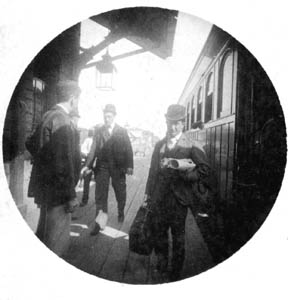 |
From the July 3, 2003, issue:
Leaving for home after Commencement, diploma tucked under his
arm, is Baltimore's Edgar Allan Poe 1891. (His father, John
Poe 1854, was a cousin of the poet.) Edgar and his five brothers
contributed to many Princeton football victories between 1882
and 1902. During the Harvard game in 1889, an alumnus was asked
by a Harvard man if Poe was related to the great Edgar Allan
Poe; the alumnus responded, "He is the great
Edgar Allan Poe." |
|
|
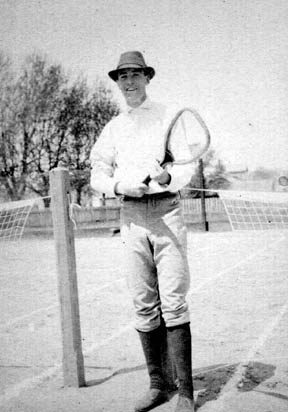 |
From the June 4, 2003, issue:
William "Silas" Whitehead, Class of 1891, is nattily
dressed to play what was long the most popular game at Princeton.
Tennis began as an organized sport in 1882, when a group of
undergraduates formed the Princeton Lawn Tennis Association.
In 1884, Princeton joined the newly founded Intercollegiate
Lawn Tennis Association. Since then, Princeton men's tennis
has become the school's most successful men's varsity sport,
with an all-time record of 864 wins, 250 losses, and six ties.
Women's tennis, introduced in 1971-72, was one of Princeton's
first women's varsity sports. |
|
From Brad Bradford ’44:
When I chose Princeton in 1940, one of its lures was Beasley's
reputation. I practiced with the freshman contenders that fall
and intended to try out in the spring even though I may have
been far outclassed. But a Rockford friend, Clayt Gaylord, was
president of the Rugby Club and the prospect of a spring trip
to Nassau and playing before the Duke and Duchess of Windsor
proved too good a deal to pass up. I never played tennis seriously
again until the 1960s.
Coach - Protege Twist Serve Tale
The mention in the June 4 From the Archives item that men's
tennis has been Princeton's most successful men's varsity sport
brings to mind the strange relationship of Mercer Beasley and
Frank Parker. Beasley coached the Tiger netters to undefeated
seasons in '33, '34, and '38 and to Eastern intercollegiate
championships in 1933, 1938, and 1941. He was inducted posthumously
into the College Tennis Hall of Fame in 2001. Beasley had tutored
Frank since he was 12 years old, and his second wife, Katherine
Brown, had served "practically (as) a foster mother to
her husband's protege."
But Katherine was closer in age to Frank than to Mercer. In
1938 she divorced Beasley to wed the 22-year-old Parker, who
would go on to win national singles titles in 1944 and 1945.
Beasley said after the wedding that he had learned of the relationship
a year earlier. "Both came to me and told me in my own
house that they were in love," said Beasley. "They
said the romance had been going on for three years." Frank
would celebrate the silver anniversary of his wedding to his
"foster mother," and the marriage would continue until
Katherine's death years later. Frank died about the turn of
the century. (I can't pin either one death date, but Frank was
still teaching at the McClurg Center in downtown Chicago when
I moved here ten years ago.) |
|
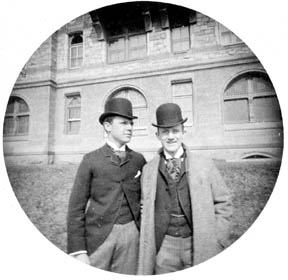 |
From the May 14, 2003, issue:
Where are these dapper seniors going? Houseparties? Or just
a regular day of classes at Princeton in 1891? Dressed in rather
formal attire, William Bergen and William Deemer, both Class
of 1891, pose in front of Witherspoon Hall. The image is part
of the University Archives' Student Photographers Series. |
|
|
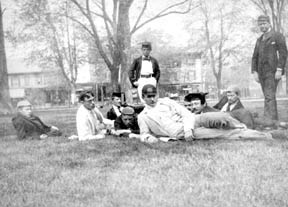 |
From the April 23, 2003 issue:
From the Student Photographers Series comes this photograph
taken in the spring of 1891. A group of seniors laze about the
green in front of Nassau Hall (Nassau Street is in the background).
Pictured from left are Harmar Paxton, Paul Cary, William Spicer,
Robert Watts, Isaac Brokaw (Class of 1893), George Dugan, Robert
Robertson, Robert Strong, and Benjamin Jones. |
|
|
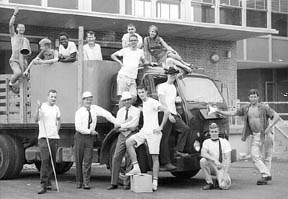 |
From the April 9, 2003 issue:
Don Kratz ’62 sent this photo from the summer of 1962.
The truck (named Elvira) and its crew had moved all the furniture
from the Green Engineering Building to the new
E-Quad in time for the start of fall classes. Professor John
Whitwell is in the tie and hard hat, and Kratz himself is shown
in front with the stick. “It was a lively summer,”
he says, “though some names have faded from memory.”
Anyone recognize himself — or herself? |
|
From Dennis Fowler ’63
p’94: With regard to the From the Archives photo in
the April 9 issue, yes, the names have faded over the years.
But then, I'm notorious for forgetting names.
I'm the dapper chap in the black stetson standing on the running
board. I was Elvira's primary driver that summer, and still
grieve over the time a telephone pole attacked her, damaging
one of her side mirrors.
Elvira was of modest endowments, at least in terms of what are
considered female attributes, but sturdy constitution. On her
bow she wore a bra, found in a restroom at sometime during our
efforts. It was an "AA" cup size, if I remember correctly.
Complaints by town residents led to its removal, but being a
sturdy lassie, Elvira bared her attributes without shame. She
had a tailgate with a hydraulic lift which would have given
her the power to pick up a whole squad of sailors at one time,
had we let her.
I took away many lessons from that summer, the most valuable
being how to move, single-handedly with no more than the aid
of a dolly, a double pedestal Steelcase office desk. |
|
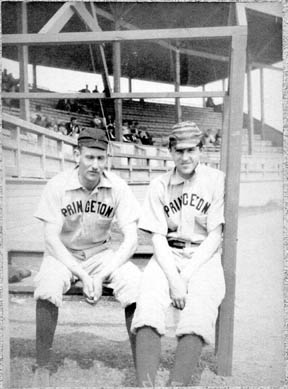 |
From the March 23, 2003 issue:
Spring means baseball season, and from the university archives’
Student Photographers Series comes this circa 1891 picture of
two Tiger baseball players waiting in what was then called “the
battery” for their turn to get in the game. The 1891 baseball
team, captained by senior Charles C. Dana, twice beat Yale in
its final two games to end the season with a 15-6 record. |
|
|
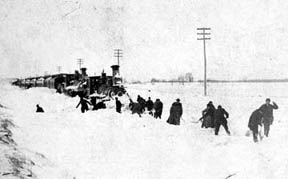 |
From
the March 12, 2003 issue:The snowy winter of 2003 brings to
mind the great blizzard of 115 years ago. Here, some two dozen
students are helping to dig out the Dinky after the blizzard
of March 12, 1888. Taken with a Kodak box camera, this photo
comes from the university archives’ Student Photographers
Series. |
|
|
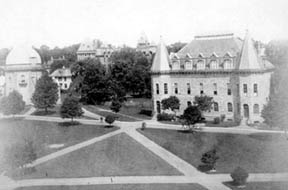 |
From the February 26, 2003
issue:This circa 1891 view from 20 Witherspoon Hall looks out
over the observatory and, to its right, the gymnasium, with
University Hall visible through the trees. Can anyone tell us
what stands in their place today? Taken with a Kodak box camera,
the photo is part of the university archives’ Student Photographers
Series. |
|
|
John ’63 and Mary Heilner: We
were delighted to see the old photo that heads up the Class
Notes page in the February 26. We were particularly interested
because we believe it shows our house situated between the
observatory and University Hall on University Place. We have
another photo, courtesy of the Princeton Historical Society,
that shows our home in this same spot, although from another
angle.
Our house was formerly known as The Cottage and was used as
the site of one of the earliest eating clubs, which consequently
called itself Cottage Club. The house was moved in 1907 to
its present position on Library Place. We believe it was moved
to make way for the expanding campus and that Campbell-Joline
and Hamilton now sit where the house and the observatory previously
were and that University Hall is now where Madison Holder
Halls are situated.
If you should have other photos showing the house, we would
be delighted to see them. We are trying to piece together
the history of the house and any and all information pertaining
to it would be most welcome.
|
Ben Kessler:
Regarding the view from Witherspoon Hall c.1891 pictured in
the February 26: Halsted Observatory (1865-72) was replaced
by Joline Hall in 1932; University Hall (originally University
Hotel, 1875-76) was demolished in 1916 and replaced by Madison
Hall; Bonner-Marquand Gymnasium (1868-70) was demolished in
1907 to make way for Campbell Hall.
|
|
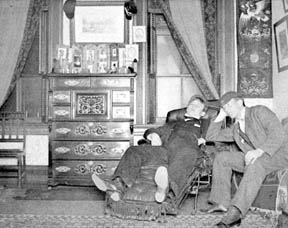 |
From the February 12, 2003 issue: This circa 1891
dorm room looks quite a bit more ornate than those of today
— notice the elaborate dresser, tapestries, carpet, and
curtains. The photographs’s lounging students, however,
despite their formal dress, prove that the art of dorm-room
“hanging out” hasn’t changed. This photo, taken
by a student with a Kodak box camera, is part of the university
archives’ Student Photographers Series. |
|
|
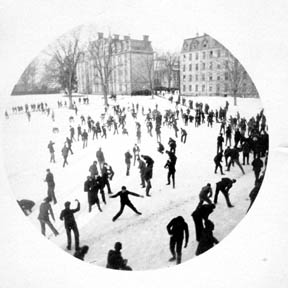 |
From the January 29, 2003
issue: This circa 1891 student photograph shows a boisterous
snowball fight, with West College and Reunion Hall in the background.
With all the snow Princeton has had this winter, perhaps a school-wide
snowball fight could replace the now-banned Nude Olympics as
a wintertime tradition? The photo, part of the university archives’
Student Photographers Series, was taken with a Kodak box camera. |
|
| |
|
|
|
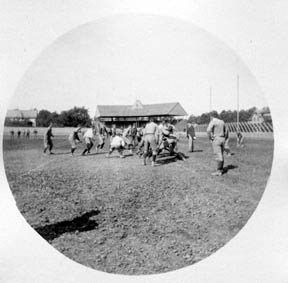 |
From the 12/18/02 issue:
This 1891 student photograph of a Princeton football practice
was taken with a Kodak box camera. With the camera’s introduction
in 1888, student photography became more common, and some Tigers
may even have developed their own photos in the John C. Green
School of Science. The players out on this field are part of
Princeton football history, as the 1891 season still holds the
record for the longest streak of games (12) in which the Tigers
were unscored upon. |
|
| |
|
|
|
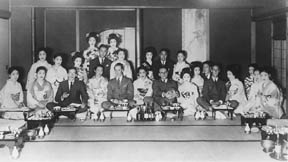 |
From the 12/04/02 issue:
From the personal collection of Henry Patton ’35 comes
this photo from a party given for several recently graduated
Princetonians who traveled to Japan at the invitation of classmate
Muneyori Terashima ’35, or “Terry.” Pictured
with the many women are (standing) Terashima, (sitting) Oliver
Langenberg ’35, Doug Gorman ’35, friend Champ Robinson,
Masaru Debuchi ’34, and Patton. While there was sake and
even Scotch to be had, Patton recalls of the party, “I
thought it would never end.” |
|
| |
|
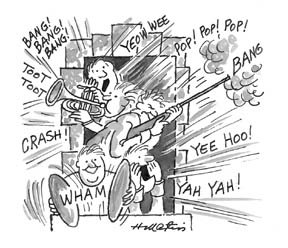 |
From the 11/20/02 issue:
In the 19th century, a “poler” was an overzealous
student. For Poler’s Recess, a respite from the grind
of exam preparations, undergraduates threw open their windows
at the 9 p.m. curfew and made as much noise as possible to
relieve tension. From musical instruments to shotgun fire,
students produced a clamor so admirable that in 1918 local
soldiers thought the Germans were invading. Poler’s Recess
faded in the mid-1930s and disappeared during the ’40s.
In January 1949, it resumed, and Holder Hall residents were
commended in the Prince for their use of firecrackers and
flaming tennis balls. But the revival did not take hold, and
Princeton’s raucous version of the primal scream became
a campus memory.
|
|
Stephen Lardieri '94: Regarding the Poler'sRecess of
years gone by: In the early 1990s, the residents of Rockefeller
College revived the tradition of auditory stress relief, renaming
it the Holder Holler. Each night at midnight — undergraduate
curfews being somewhat later than they were in previous eras
— the windows of Holder would fly open, and the courtyard
would fill with the primal screams of overworked freshmen and
sophomores. Quickly would the cry spread to the Blair Courtyard
in Mathey, thence to the rest of campus.
Whether the tradition continues, I do not know.
|
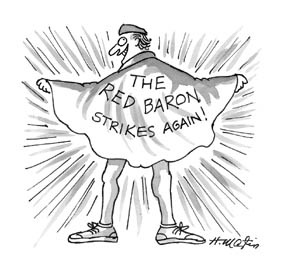 |
From the 11/06/02 issue:
During the late 1960s and early ’70s, many campus pranks
involved nudity. One of the most mysterious characters was the
Red Baron, who ran through classrooms dressed only in red accessories
(such as a World War I flier’s hat, and a cape and tennis
shoes). This era also saw the start of the rugby team’s
annual springtime “jock runs,” wearing either jockstraps
or nothing at all. During Houseparties weekend in 1966, some
Cannon Club members and their dates staged an early morning
game of nude volleyball. Even before Richard “El Deuco
Perverto” Goodman ’74, Charlie “The Streak”
Bell ’76, and the streaking craze of 1974, nude sprints
around campus were not uncommon. |
|
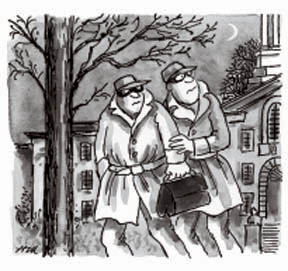 |
From the 10/23/02 issue:
In March 1864, a daring undergraduate climbed the Nassau Hall
tower and took the bell clapper. Since students were called
to class by the bell, a missing clapper was an excuse to skip.
In later years, stealing the clapper became a rite of honor
for freshmen, and students became creative in their attempts
to uphold tradition. Many scaled the outside walls to reach
the cupola; others hid inside the building until the late
hours. In 1986 students dressed as workmen removed the clapper
in broad daylight.
The university vacillated between making it easier and harder
for student thieves. In lenient times, Nassau Hall was even
left unlocked. But when students were injured one year, the
university installed alarms in the belfry. The clapper was
permanently removed in 1992, when a student fell from the
roof and was badly hurt.
|
|
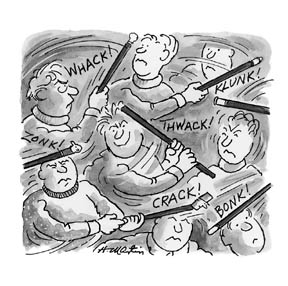 |
From the 10/0902
issue:
In 1865 freshmen were not allowed to carry gentlemen’s
canes; this privilege was reserved for sophomores and upperclassmen.
One evening, when impudent freshmen were strolling on Nassau
Street with their carved sticks, sophomores attempted to seize
the canes, and a small riot erupted. Within several years, the
behavior became formalized into an annual battle between the
two classes. Selected representatives would fight for possession
of a cane, after which entire classes would participate in a
“rush.” By the mid-1930s, one goal of this giant melee
was the removal of the rival class’s clothing. After World
War II, the Cane Spree competition was managed by the Department
of Athletics. |
|
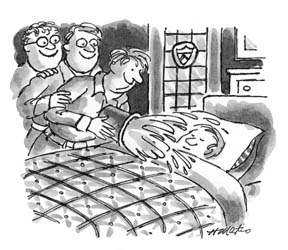 |
Fromthe 9/11/02 issue:
Hazing was a part of Princeton student life since the earliest
days of the College of New Jersey, though the practice had multiple
names and forms over the years. Sophomores taught freshmen their
place in the social hierarchy by forcing them to perform degrading
acts, awakening “newys” with cold water, head shaving,
and occasional physical abuse. Though hazing was technically
forbidden by the 20th century, the nearly identical practice
of “horsing” rose in its place. After horsing was
abolished, freshmen were still subjected to extensive restrictions
on their behavior and dress, such as mandatory “dink”
wearing. Though these customs eased up during World War II,
postwar classes attempted to revive some of the traditions,
resulting in “dink wars” and a revival of head shaving.
By the mid-1960s, however, freshmen hazing fell out of popularity
and practice. |
|
| |
| |
|